"Missing" in the Kharkov boiler
On the frontline fate 106-th National Cavalry Division, formed in Akmolinsk, says the head of the student search team "Memorial Zone" Maidan Kusainov.
Professor of ENU. L.N. Gumilyov more than 20 years headed the student search group "Memorial Zone". Each year, the commander of the kusainov goes with a detachment of students to Sinyavino heights near St. Petersburg and to the villages near Kharkov. Where, in 1941, our countrymen fought heroically against the fascists, the soldiers of the 106 National Cavalry Division, 310 and 314 rifle divisions formed in Akmolinsk and Petropavlovsk.
They look intently into our eyes, the commanders of the 106-th National Cavalry Division. Fifteen commanders: division commander, deputy commander, chief of staff, regiment commanders and senior regiment political officers. Courageous, resolute and strong-willed person convey unprecedented energy and willingness to smash the invader into the homeland of the invader. There is no doubt that they will fight boldly, bravely and skillfully, dragging the fighters and commanders of the cavalry division behind them.
It could not have been otherwise. After all, the picture was not taken in July-August 1941, when the Red Army, stubbornly clinging to every inch of its native land, was retreating, the picture was taken on April 5, 1942, after the defeat of the Army Group “Center” near Moscow. Those commanders and political instructors express the expectation of the spring-summer offensive in order to expel the invaders from the borders of the Fatherland.
5 April 1942 of the year. Commanders and political officers of the 106-th Kazakh cavalry division. Top row: 1 on the left - senior political officer Kulmagambetov Sagadat Mendygazinovich, 3 th on the left - deputy. division commander for political work, political commissar Seitov Nurkan, left 5, perhaps divisional Pankov BN, left 6, possibly deputy. division commander Borisov AB, 7 or 8 on the left, possibly the beginning. General Staff Osadchenko P.M. Middle row: 2 on the left - Chief of the Special Section Utebaev Uali Gusmanovich, 3 on the left - Regiment Commander Major Uvaysov Tazhigali. Bottom row: 2 on the left: senior politruk Kapazhanov Kairbek, 3 on the left — squadron commander st. Lieutenant Beysembekov Mukan. The rest is necessary to identify relatives and friends.
They could not know that at the moment when they posed for the photographer, their front-line fate was decided - none of them broke from the Kharkov cauldron. The fatal share fell not only to them, but not to one hundred thousand fighters and commanders of the Southwestern troops who participated in the Kharkov offensive operation of May 1942. In the hell of the Kharkov boiler, both the soldier and the general were equal, and they went to break through the encirclement, if truthfully, under the lead of the shooters, to be mowed down with dagger fire and not to be captured.
And so the fighters and the generals in the vicinity of the little-known village of Lozavenko, unidentified, are recognized as “missing”. There will be no other photos, except those taken before being sent to the army in Akmolinsk. There will be no more time for photography. The war since the arrival of the fighters in the army has swiftly spun their front-line fate, for which she allocated just 18 days - from 12 to 30 in May 1942.
How did the frontline fate of the 106-th National Cavalry Division and its commanders and fighters? The fate of the arrival of the first echelon of 28 in April and the last 12 of May 1942 in the current army until the beginning of the Kharkiv offensive operation on 12 in May and its tragic end in 30 in May 1942. included in the shock 18 of the cavalry corps, breaking through the front, marched through the enemy’s rear, smashing the SS elite unit, covering the withdrawal of the main forces of the shock force, Major General L.V. Bobkina, broke out of the ring of encirclement at an unknown village of Lozavenka, where they fell along with the generals of the Southwestern direction on the battlefield. In total for 1942 days, they experienced the triumph of the winners and liberators of cities and villages and experienced the bitterness of irretrievable losses in the heat of the ring of the environment.
How was the war situation in Barvenkovskiy ledge from 17 in May, when the Wehrmacht general Kleist, east of D. Lozavenka, closed the encirclement of the troops of 6, 57 and army group of General L. V. Bobkin, on 30 in May 1942, when 239 000 fighters and commanders were taken prisoner, only 22 000 fighters and commanders managed to escape from the environment, no one knows how many people died during the breakthrough of the inner, middle and outer rings of the environment, and is unlikely to know.
There are not and will not be any documents revealing the course of battles for attempting to break through the ring of encirclement, since the surrounded divisions before the breakthrough either buried the safes with the documents or destroyed them if the breakout was unsuccessful. There is a chance that they could fall into the hands of the enemy. Therefore, the chronology of the battles in the cauldron can only be formed by a combination of the analysis of traditional military actions of generals who find themselves in the environment, taking into account the memories of those who escaped from the environment, data from the memoirs of Bagramyan I.Kh. and the German generals Kleist, Lanz, Boca, and the ability to get used to the conditions of the Kharkov boiler as a squadron commander, combat commander, commander, commander and division commander of 1941 and 1942. I think I managed to get used to, feel and reconstruct the battles in the cauldron.
23 May 1942 years
23 May 1942, east of the village of Lozavenka, Kleist's army group closed the encirclement of the southwestern troops in the Barwenkoff ledge. At the village of Beautiful on the plane U-2 (on the night of May 23) the deputy arrives. commander of the South-Western Front, Lieutenant-General F.Ya. Kostenko, appointed Marshal S.K. Tymoshenko, commander of the Southern Group of Forces uniting 6, 57, army and army group of General L.V. Bobkina. On the radio, all divisions still located near the town of Krasnograd, near the village of Paraskoveya, Okhoche, Verkhniy Bishkin, Sakhnovshchina, Aleksadrovka, the commander ordered him to move to the village of Lozavenka, to organize a breakthrough of the encirclement ring.
In reserve, Lieutenant-General F.Ya. Kostenko were the 103-rifle division, located east of the village of Alekseevka, and the incomplete 106-i national Kav. division (288-th cav. regiment, arrived 11 and 12 in May, and an incomplete composition of the 307-th and 269-th cav. regiment), located southeast of the village Alekseevka. F.Y. Kostenko sent 106-th Kav. division and 103 th rifle division to meet the forces of Kleist, occupied the village Volvenkovo, Kopanki, Mikhailovsky, with an order to dig in to the east of the village of Lozavenka and keep approaches to the village until the approach of the troops of the 6 army General A.M. Gorodnyansky and the army of the army group of General L.V. Bobkina.
Cavalrymen of the 106th National Cav. the divisions and infantrymen of the 103rd Infantry Division had to advance along the deep ravines "Ruined", "Steep log", "Mikhailovsky", as the air dominated aviation the enemy. More maneuverable 106th cav. the first division arrived in the village of Lozavenka. The German infantry only approached the eastern outskirts of the village and was thrown back by a surprise cavalry attack from the Salt Bar. Since the cavalry had almost no rifles, the attack allowed to capture several rifles and one MG-34 machine gun. Towards evening, with the 103rd Infantry Division approached, cavalrymen dug in on the eastern outskirts of the village of Lozavenka, dug 45-mm anti-tank guns.
24 May 1942 years
On the night of May 24, to the cavalrymen of the 106th cavalry who had dug in on the eastern outskirts of the village of Lozavenka. divisions and infantrymen of the 103rd Infantry Division were sent spotters of a separate artillery regiment of 76-mm guns. In the morning spotters of 152-millimeter guns approached, and in time: noise was growing in the east tank motors. The spotters, having climbed onto the roof of the tallest building, determined the coordinates of the tank column by radio, transferred the targeting to the batteries, and continuous explosions covered the tank column.
Thus, enemy tanks and infantry were stopped on the outskirts of the village of Novosserpuhovka.
25 May 1942 years
From morning to evening on May 25, the troops of the 6 Army and Army Group L.V. approached the Mikhailovsky Log and Krutoy Log. Bobkina.
26 May 1942 years
On the morning of May 26, the troops of the southern group launched an offensive to break through the encirclement ring. The first echelon of the shock group included the 103-I division, 317-I division. Before the infantrymen were concentrated cavalrymen 106-th Kav. divisions and especially a pair of horsemen with lassoas, and tank units of the 23 tank corps. As a result of fierce battles, during which the enemy suffered considerable damage, only a few managed to escape. The encirclement ring was broken only for a short time, and then because of the enormous superiority of the enemy and the maneuvering opportunities that he had, the breaches made with enormous efforts by our soldiers closed again.
On this day, the commander of the southern group and his headquarters made heroic efforts to save personnel, military equipment and weapons from the incessant massive air raids and strikes of enemy artillery, to establish control and prepare more decisive actions to break from the environment [1].
In the vicinity of the still unknown village of Lozavenka, from 26 to 29 in May, battles continuously thundered, due to bitterness and bloodshed that have no equal in World War II, where the Red Army generals went to break through the ring of encirclement, shoulder to shoulder with their soldiers and commanders, and fell under the cross machine-gun fire mountain shooters. The diary of General Kleist recorded: "On the battlefield, everywhere, as far as the eye could see, the ground was covered with the corpses of people and horses, and so tightly that it was difficult to find a place to drive a car."
The cavalrymen of the 6-th cavalry corps lay along with them, Akmola, Karaganda, North-Kazakhstan, Pavlodar, Chimkent from the 106-th Kazakh cavalry division. The one who survived was taken prisoner, where political officers and commissars were separated right near the village of Lozavenka and immediately shot. Like everyone else, who are considered missing, Kazakhstani cavalrymen lie on the field under Lozavena, which General von Kleist had been observing after the battle.
In the historical work of the German historian, a participant in the war, Paul Karel writes: “The ensuing battle at Lozavenky was one of the bloodiest in the whole war in Russia. We find the story about this in the 1 archive of the mountain rifle division of Major General Lanz. Under the reflections of thousands of white rockets, Russian columns attacked the German frontiers. With their pistols waving, the commanders and commissars drove their battalions forward with sharp cries. Shoulder to shoulder, clasping their hands, the Red Army men went to storm, hoarse “Hurray!” Hysterical roared into the night.
- The fire! - commanded the German obrefreytory machine guns and infantry guns. The first wave of attackers failed. Brown as the ground, the columns turned north. But here, too, they ran into blocking positions of mountain shooters. The waves of the Russians rolled back and again, regardless of the losses, attacked and attacked the Germans. They crashed anything and everything on their way, fought off several hundred meters from the enemy, but then the onslaught weakened, and the menacing shafts collapsed under heavy barrage of German machine-gunners. Those who did not die stumbled and stumbled, or crawled back into the ravines of the Berek River ”[2].
26 May 1942, the commander of the group of troops Von Bock, in his diary, made a note: “... I am going through the Bright group, the 44 and 16-th tank divisions in the 60-th motorized and 1-th mountain divisions. Everywhere the same picture: everything an already compressible enemy nonetheless does here and there attempts to break through, but he is already standing directly in front of a crash. From one height to the southeast of Lozavenky, it was possible to see how the fire of our batteries beating into the smoking “boiler” gets an increasingly weaker response ... Crowds of prisoners flow to the rear, our tanks and 1 mountain division units are attacking. amazing picture.
27-29 May 1942 Year
On the night of May 27, west of Lozavenky, the units and formations were concentrated, covering the withdrawal of the army group of General AM Gorodnyansky: 47-Infantry Division, 393-Infantry Division. By the morning of May 27, the 266 th Infantry Division of A. N. Tavantseva, which fully retained its combat capability, approached. The remaining tanks of the 21 tank corps came on the run. The headquarters of the southern group of Lieutenant-General F. Ya. Kostenko grouped troops to re-break the newly closed encirclement ring. The tanks of the T-3421 tank corps with a full-fledged 266 rifle division were deployed in the front ranks of the strike force. After that, the bloodless units of the 393-rifle division, the 47-th rifle division, the cavalrymen of the 6-th cav. the corps that survived the night attack and retreated to the rear, and with them the remnants of the 106 th regiment of the Kazakh Kav. divisions. With the second wave of attackers, all the generals headed by the commander of the southern group of troops F. Ya. Kostenko were to leave the encirclement. On the night of May 28, the last organized strike group of troops, now headed by generals, went to break through the ring of encirclement near the village of Lozavenka.
The first echelon of the shock group, made up of the remains of tanks of the 21 tank corps, fighters and commanders of the 266 division, broke through the encirclement east of the village of Lozavenka and by the morning of 28 in May went to the Volvenkovo, Volobuyevka area. Together with them, the other units and subunits that were located west of the village of Lozaveкаka also made their way here. On the night of May 29, this grouping of troops with a blow from the rear, with the assistance of the troops of the 38 Army, broke through the enemy front line on the right bank of the Seversky Donets and successfully entered the location of the main forces near Chepel [3].
In his memoirs about this episode, Marshal of the Soviet Union K. S. Moskalenko writes the following: “... I remember, six T-34 tanks were the first to arrive. One member of the Military Council of the South-Western Front, divisional commissar K. A. Gurov. Thousands of Soviet soldiers led by Major General A were following the waves in waves. G. Batyunya. Through their pain and fatigue, their faces shone with the exorbitant joy of returning to their own ... only about 22 thousand soldiers and commanders came out ... ”[4].
Following the first echelon of the attackers, there was a group of generals of staffs headed by Lieutenant-General F. Ya. Kostenko, but the German snipers in the chains of the advancing routinely chose commanders and especially political instructors, and knocked them out. Artillery fire did not understand where the private, where the general. The following people died in combat this night: Commander of the Southern Group of Forces Lieutenant General F. Ya. Kostenko, Commander of the 6 Army, Major General A. M. Gorodnyansky, Commander of the 47 St. Division, Major General P. M. Matykin, commander of the 270 pp. division, Major General Z. Yu. Kutlin, commander of the 393 pp. division, hero of the Soviet Union, Colonel I. D. Zinoviev, commander of the 21 tank corps G. I. Kuzmin, commander of 150- Major General D. G. Egorev, General of the Artillery F. G. Malyarov, Commander of the 7 Tank Brigade, Colonel I. A. Yurchenko [5].
This is how the German historian Paul Karel describes the fury of battles under the village of Lozavenka: “The next evening, everything happened again (on the night of May 28). But this time the infantry attack was supported by several T-34. The Russian soldiers, who also all clasped their hands, were under the influence of alcohol, how else could these poor things go to death with shouts of “Hurray!”? ”
Indeed, from where the Soviet command could have had vodka, if there were not even crackers in the warehouses.
When somewhere after the Germans had captured the stronghold of the enemy, it was possible to reject a decisive counterattack, the Germans found the bodies of defenders with skulls butted with torn-off bayonets, and those beaten by Russian boots beyond recognition. The parties fought with wild rage. This battle was a terrible road to death.
On the third day, the onslaught of the Russian forces was asleep — the Germans managed to reach a turning point. Both the commanders of the Soviet 6 and 57 armies, Lieutenant-General Gorodnyansky and Lieutenant-General Podlas, along with officers of their headquarters, lay dead on the battlefield. The battle ended with the defeat of Tymoshenko. The enemy lost the main forces: twenty-two rifle and seven cavalry divisions. Fourteen tank and motorized brigades were completely destroyed. Around 239 000 Red Army captured. The Germans destroyed or took 1250 tanks and 2026 guns as trophies.
Thus ended the battle south of Kharkov. The battle in which Soviet troops who tried to encircle the Germans themselves became surrounded.
Literature
1. Bagramyan I. Kh. So they went to victory, M., Voenizdat, 1977, p. 120-121.
2. Paul Karel. Eastern front. Book One. Hitler goes to the East. 1941-1943. M .: Isografus, EKSMO, 2003, p. 406-407
3. Bagramyan I. Kh. So they went to victory, M., Voenizdat, 1977, p. 121.
4. Bagramyan I. Kh. So they went to victory, M., Voenizdat, 1977, p. 122.
5. Heart, obpalena vyuynoyu. Kharkiv, 2010, p. 11-12.
- M.K. Kusainov, Cand. tech. Sciences, Professor ENU. L.N. Gumilyov
- http://e-history.kz/ru/publications/view/746
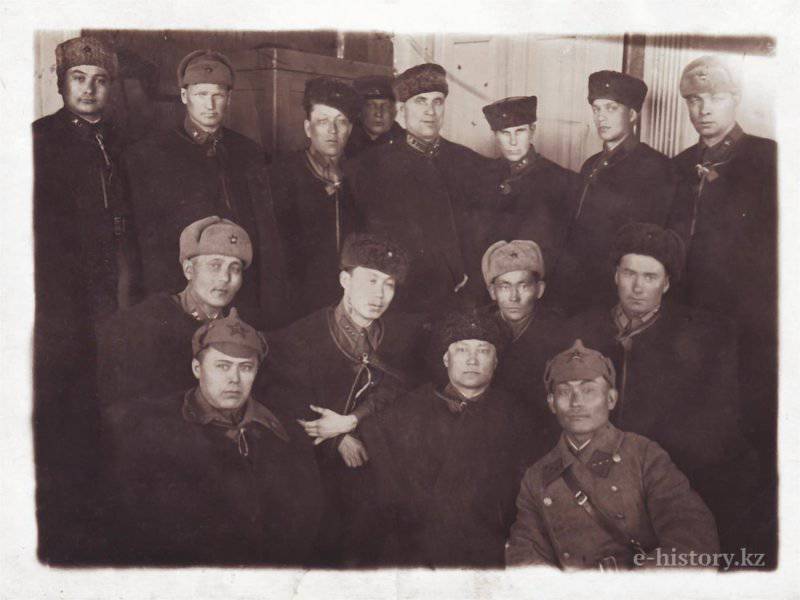
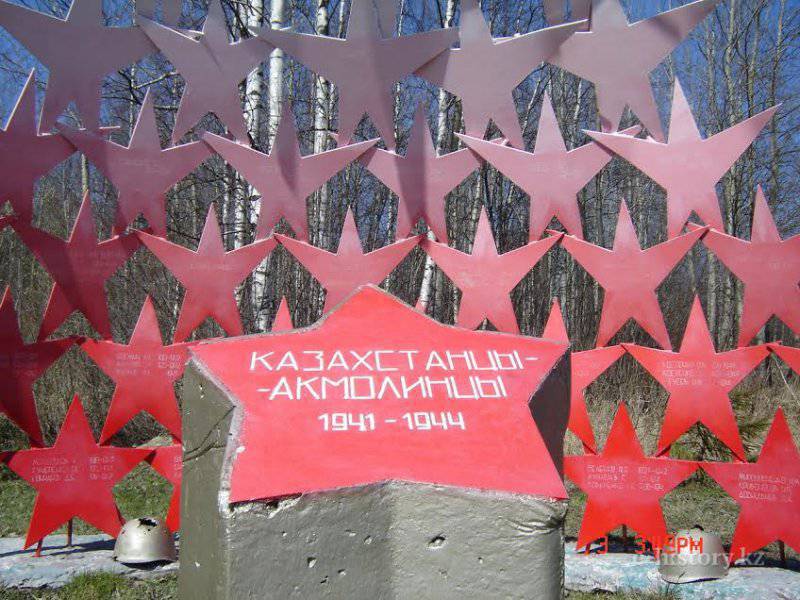
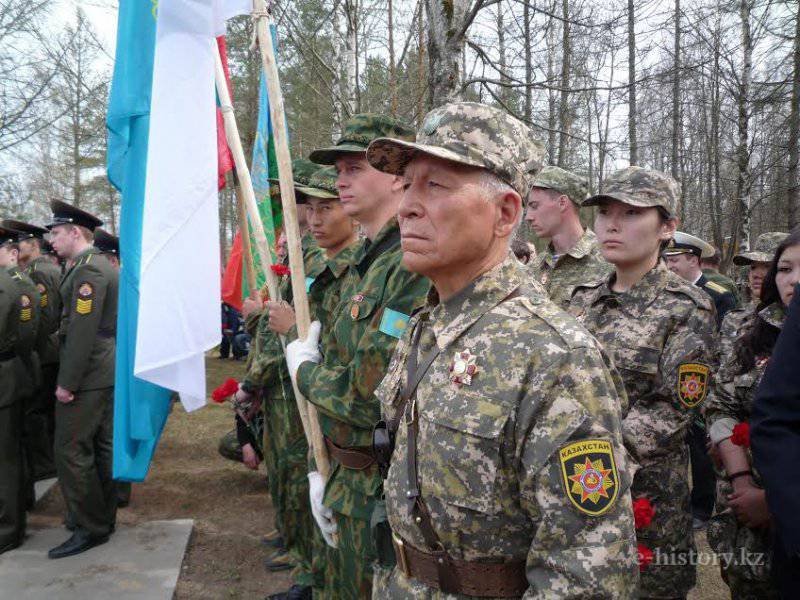
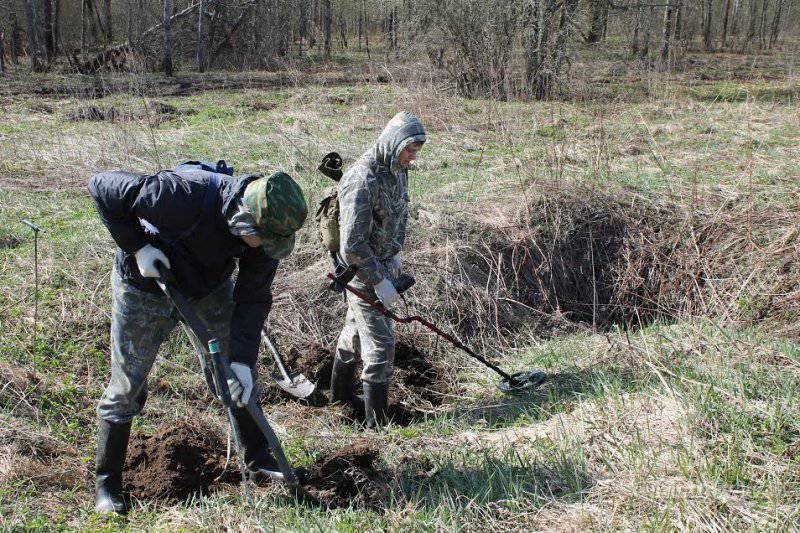
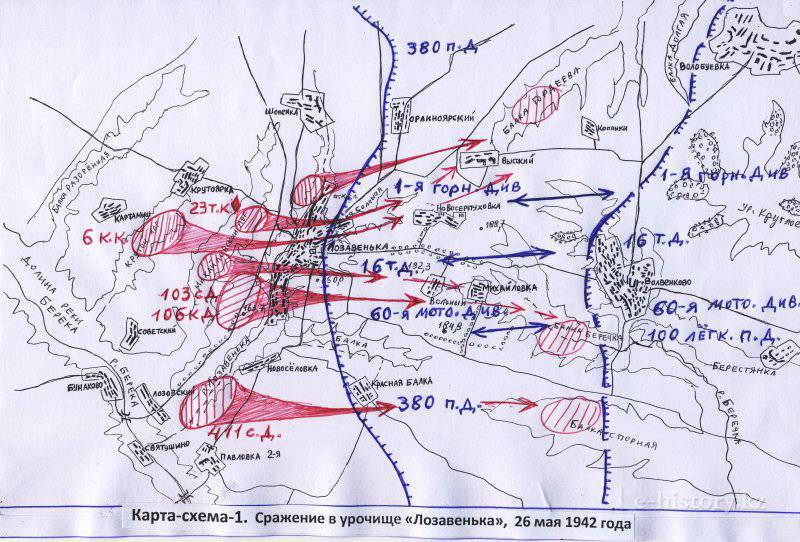
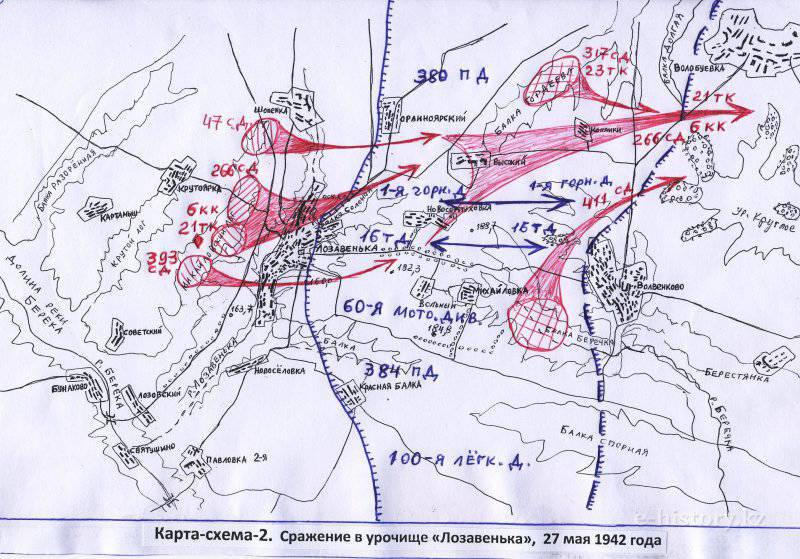
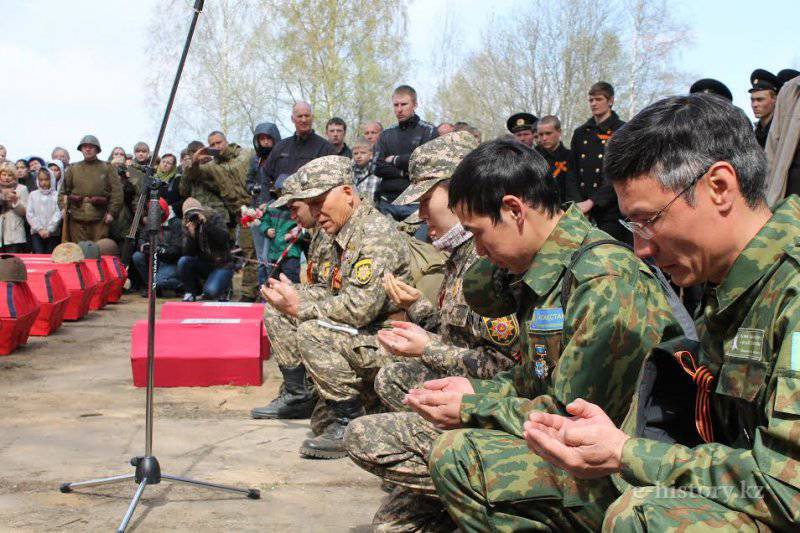
Information